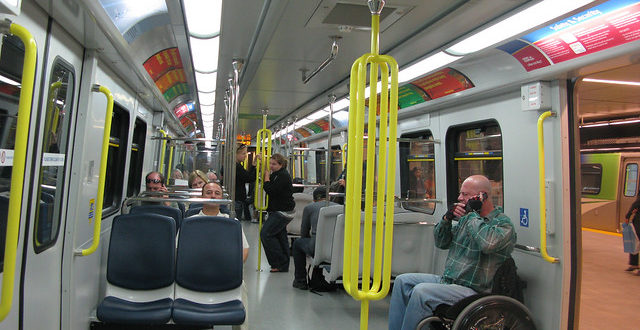Across Britain, public transport is still proving to be a very popular choice for many of us for getting from A to B. A report leaked by the Department for Transport’s Transport Statistics, Great Britain 2018: Moving Britain Ahead, claimed that there were 4.85 billion local bus passenger journeys completed throughout the UK during 2017 to 2018 and 1.71 billion National Rail passenger journeys were also completed. During the same time period, there were 270 million passenger journeys recorded on light rail and tram systems, which is a record since comparable records commenced.
Taking our focus on just England alone for the period covering 2016 to 2017, the Department of Transport discovered that the population held 9.8 million older and disabled concessionary travel passes as well. With that in mind, is there enough being done to make the nation’s means of public transport accessible for disabled people and the elderly though? With assistance from bespoke stairlift manufacturer Acorn Stairlifts, we’ve investigated this issue…
Highlighted issues with accessibility on public transport
Jamie Hale, who is a UK-based poet had expressed his disappointment about how he feels towards Britain’s transport system and that it doesn’t cater enough for disabled people in an opinion piece for The Guardian, going as far as to state that London alone “has one of the best public transport systems in the world, yet only about a quarter of underground stations are fully accessible for me”.
Mr Hale is also an activist with groups like Disabled People Against Cuts, and Not Dead Yet UK was also keen to point out some of the positives linked to the capital’s public transport system. He accredited buses in the city for having wheelchair-accessibility and the pavements are passable, while a system entitled Turn Up & Go is designed to allow passengers who are disabled to travel spontaneously.
Though, he goes on to express that London’s rail network puts a reliance on staff-assisted travel for many of disabled passengers. Using a real-life situation, Mr Hale had said that this means he must wait for a staff member to set up a ramp and then assist him with boarding the train – many times of which he ends up travelling within the vestibule of the transportation system.
Mr Hale added: Even when the train has a wheelchair space, I’m rarely put in it. If I want to get off, I have to hope the staff remember me. They often don’t, leaving me either shouting at passengers to find platform staff or relying on friends. Otherwise, I have to eat into my care hours and bring a carer with me who can find staff when I’m inevitably forgotten. Of my last six journeys, I was only met correctly on two — the rest of the time, the ramp didn’t arrive, or it was sent to the wrong part of the train.”
The artist and poet had shared some potential solutions for making both London’s and the wider UK’s transport system more accessible by including:
- Ensuring all trains have proper spaces for wheelchair users.
- Improving how those requiring assistance to alight from public transport can alert staff members on a platform when the necessary help hasn’t arrived.
- Increasing the number of dedicated assistance staff members available for those using public transport.
- Introducing automated ramps which extend from trains to platform level.
- Making it free for carers and assistants to use public transport.
Mr Hale isn’t the only one who has been frustrated with these issues. Within its Independent. Confident. Connected report, the disability equality charity Scope found that 40 per cent of disabled people often experience difficulties or issues when travelling via train across the UK. One in four also stated that negative attitudes from fellow passengers has led to them restricting their use of public transport.
James Taylor who is head of policy and public affairs at Scope, commented: “From airports to buses, we’ve heard too many horror stories of disabled people let down by poor infrastructure, bad service, or being treated as an afterthought. This urgently needs to change.
“A genuinely inclusive transport network would allow disabled people to be part of their community, work, and see family and friends. Progress towards fair and inclusive transport has been slow, and disabled people want to see change happening a lot faster.”
Legal rights for accessibility transport
The 2010 Equality Act, covers the legality surrounding the provision of accessible transport, and it was introduced as a replacement for all prior equality legislation, such as the Disability Discrimination Act. The premise of the act is to ensure that transport implements adjustments to provide a service for disabled people which is of the same standard to that of non-disabled people. Assistance measures should be put in place by those effected, to ensure that accessibility is met for disabled customers.
The regulations mean that providers must do the following:
- Cannot charge a disabled person extra or refuse travel to someone based on their ability
- Can only refuse a disabled person from travel as a genuine safety precaution
- Must guarantee accommodation for a disabled person where prior notice is given and without prior notice, assistance should be provided if requested.
- Provide basic assistance in the terminal, when loading/unloading luggage or boarding/alighting from the transport
- Display information in accessible formats
- Provide training for all staff members in disability awareness and handling associated equipment
- Provide compensation for lost or damaged equipment
- Must allow registered assistance dogs to travel on transport including buses and coaches
Other methods of transport have slightly varying rules, for travel by sea and waterways:
- Assistance dogs are permitted but must follow national rules
- A temporary requirement should be provided if equipment is lost or damaged
- Standards of assistance should be filed by large establishments
The Equality Act also sets out requirements for guidelines regarding public transport vehicles, such as buses, taxis, coaches and trains and there are to be outlined by the government.
The standard allowance for travel is based on a ‘reference wheelchair, which measurements are a length of 1200mm, including extra-long footplates with a total width of 700mm. The sitting height from ground to top of head shouldn’t exceed 1350mm and the height of the footrest will be no more than 150mm.
To justify all wheelchair sizes, the ‘reference wheelchair’ is the bigger then most models, which guarantees that users will have enough room. Some models are bigger however, and they may be unable to travel. Theoretically, if your wheelchair fits these requirements then you should be allowed to travel with it. If you are concerned about the size guidelines, you should contact your travel operator ahead of time for assurance, as many can provide further assistance.
For mobility scooters, the requirements for them is that they need to be folded in order to travel, but smaller models are permitted on some buses and trains.
Further measurements for increasing accessibility on transport
The success of the journey, can come down to essential planning and there are various organisations who offer free advice. For blind or partially sighted customers, Describe Online is an example as it provides text descriptions of the layout of public spaces. Many transport facilities also rely on announcements to communicate with those who have limited sight, and the React AV system provides information on public spaces in an audio format.
In some major UK cities, trams are still a popular method of transports and they often have concession or discounted fares for disabled and older passengers. All services now have wheelchair accessible platforms and level access is provided in all areas to avoid the use of ramps. Most mobility scooters and wheelchairs are allowed to travel on trams, but some do so on a permit basis which the user must apply for and display to travel.
The capital has also recognised the need for an increase on accessibility. Transport For London are at the forefront of making their services inclusive to all abilities, including those with hidden disabilities. The in introduction of the ‘Travel Support Card’ enables users with any form of disability to seek assistance from staff if necessary, and the user can note down any important details to give staff a better idea of the support which they could provide.
Local communities across the UK are also experiencing a growth of accessibility, with services such as door-to-door whereby people can rely on transport coming directly to their home. If you are unable to use public transport with your wheelchair, you could benefit from one of these services, often known as ‘dial a ride’, and your wheelchair can travel with you. These services are usually provided by local councils or authorities, and those who wish to use the service should consult the relevant authorities or the community pages in the phone book.
When it comes to ensuring that all customers feel safe and secure regardless of their ability, the transport sector is certainly making advances. It is becoming more than just a matter of getting from a to b, as the inclusive nature of the facilities available becomes an important factor for those who want to use their services.
 Travellers Club The Travellers Club, a free to join on-line club for everyone who loves to travel.
Travellers Club The Travellers Club, a free to join on-line club for everyone who loves to travel.









